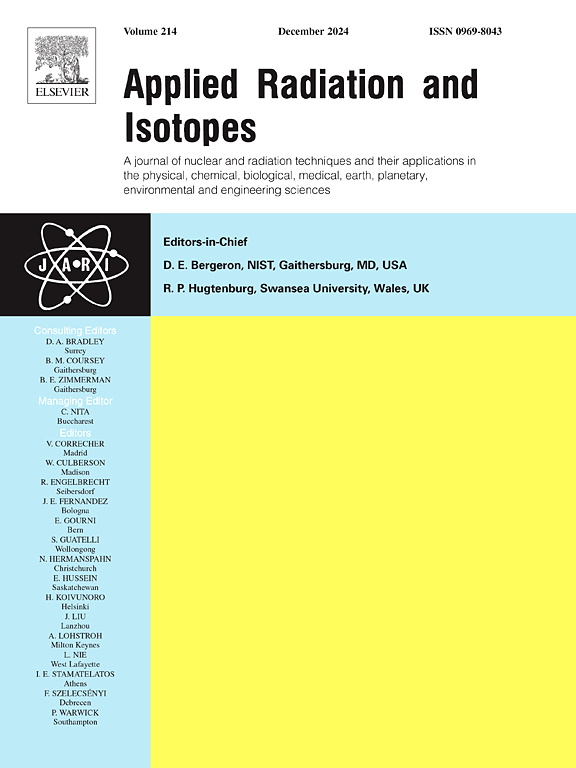Development of LiF-based ceramics for shielding neutron fluxes in boron neutron capture therapy and their performance predictions
IF 1.6
3区 工程技术
Q3 CHEMISTRY, INORGANIC & NUCLEAR
引用次数: 0
Abstract
In boron neutron capture therapy (BNCT) facilities, neutron beam-shielding materials are crucial for preventing radiation exposure and adverse events caused by beams leaking around the neutron source and gaps around the irradiation port. Owing to their stability in severe thermal, radiative, and mechanical environments, lithium-fluoride-based ceramics have been developed to shield neutron fluxes in BNCT facilities. Bulk ceramics as large as 15 cm × 15 cm × 5 cm have been successfully developed in ternary LiF-MgF2-CaF2 systems. Boron- or gadolinium-added quaternary LiF-MgF2-CaF2 systems have also been developed. These ceramics demonstrate high bulk densities of over 95 %. The particle and heavy ion transport code system (PHITS) simulation indicated that some of these ceramic tiles provided better shielding performance than commercially available 50 wt%LiF-polyethylene composite materials. We propose a variable-shaped jig that utilises the developed LiF-based ceramic beads with polyethylene beads to shield the thermal and fast neutron beams, which might leak between the irradiation port and the patient. The shielding performance of some jig models was evaluated by PHITS simulations using the initial free beam profile of the linear-accelerator-type iBNCT001 at Tsukuba. When using both the 100 wt% LiF ceramic and the 70 wt% LiF-based ternary ceramic beads containing small amounts of boron, the expected shielding performance is approximately 1/20 for thermal neutrons and approximately 1/10 for fast neutrons against the initial free beam, while the γ-ray dose rate increases by about two times. Ceramic tiles and jigs are expected to be applicable to various places in BNCT facilities.
硼中子俘获治疗中屏蔽中子通量用锂基陶瓷的研制及其性能预测
在硼中子俘获治疗(BNCT)设施中,中子束屏蔽材料是防止辐射暴露和中子源周围和照射口周围缝隙泄漏引起的不良事件的关键。由于其在严酷的热、辐射和机械环境中的稳定性,氟化锂基陶瓷已被开发用于屏蔽BNCT设施中的中子通量。在三元LiF-MgF2-CaF2体系中,已成功开发出15 cm × 15 cm × 5 cm的大块陶瓷。添加硼或钆的季系LiF-MgF2-CaF2体系也得到了发展。这些陶瓷具有高达95%以上的体积密度。粒子和重离子输运编码系统(PHITS)模拟表明,其中一些瓷砖的屏蔽性能比市售的50% liff -聚乙烯复合材料更好。我们提出了一种可变形状的夹具,该夹具利用开发的基于liff的陶瓷珠和聚乙烯珠来屏蔽可能在照射口和患者之间泄漏的热中子和快中子束。利用在筑波的iBNCT001型线性加速器的初始自由光束轮廓,通过PHITS模拟评价了几种夹具模型的屏蔽性能。当使用100 wt% liff陶瓷和含有少量硼的70 wt% liff基三元陶瓷珠时,预期对热中子的屏蔽性能约为1/20,对快中子的屏蔽性能约为1/10,而γ射线剂量率增加约两倍。预计瓷砖和夹具将适用于BNCT设施的各个地方。
本文章由计算机程序翻译,如有差异,请以英文原文为准。
求助全文
约1分钟内获得全文
求助全文
来源期刊

Applied Radiation and Isotopes
工程技术-核科学技术
CiteScore
3.00
自引率
12.50%
发文量
406
审稿时长
13.5 months
期刊介绍:
Applied Radiation and Isotopes provides a high quality medium for the publication of substantial, original and scientific and technological papers on the development and peaceful application of nuclear, radiation and radionuclide techniques in chemistry, physics, biochemistry, biology, medicine, security, engineering and in the earth, planetary and environmental sciences, all including dosimetry. Nuclear techniques are defined in the broadest sense and both experimental and theoretical papers are welcome. They include the development and use of α- and β-particles, X-rays and γ-rays, neutrons and other nuclear particles and radiations from all sources, including radionuclides, synchrotron sources, cyclotrons and reactors and from the natural environment.
The journal aims to publish papers with significance to an international audience, containing substantial novelty and scientific impact. The Editors reserve the rights to reject, with or without external review, papers that do not meet these criteria.
Papers dealing with radiation processing, i.e., where radiation is used to bring about a biological, chemical or physical change in a material, should be directed to our sister journal Radiation Physics and Chemistry.
 求助内容:
求助内容: 应助结果提醒方式:
应助结果提醒方式:


